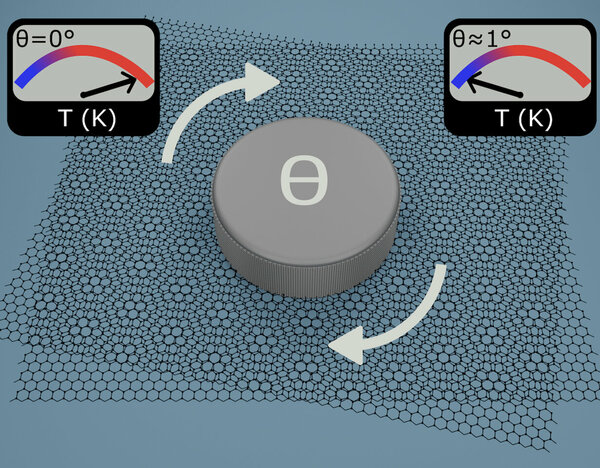What did the electron ‘say’ to the phonon in the graphene sandwich?
A TU/e and Catalan Institute of Nanoscience and Nanotechnology-led collaboration involving researchers from around the world has the answer, and the why, and the results have just been published in the journal Science Advances.
![[Translate to English:] [Translate to English:]](https://assets.w3.tue.nl/w/fileadmin/_processed_/7/0/csm_Tielrooij%20Banner%20image%20Graphene%20iStockphoto_205c0279f2.jpg)
Electrons carry electrical energy, while vibrational energy is carried by phonons. Understanding how they interact with each other in certain materials, like in a sandwich of two graphene layers, will have implications for future optoelectronic devices. Recent work has revealed that graphene layers twisted relative to each other by a small ‘magic angle’ can act as perfect insulator or superconductor. But the physics of the electron-phonon interactions are a mystery. As part of a worldwide international collaboration, TU/e researcher Klaas-Jan Tielrooij has led a study on electron-phonon interactions in graphene layers. And they have made a startling discovery.
What did the electron say to the phonon between two layers of graphene?
This might sound like the start of a physics meme with a hilarious punchline to follow. But that’s not the case according to Klaas-Jan Tielrooij. He’s an associate professor at the Department of Applied Physics and Science Education at TU/e and the research lead of the new work published in Science Advances.
“We sought to understand how electrons and phonons ‘talk’ to each other within two twisted graphene layers,” says Tielrooij.
Electrons are the well-known charge and energy carriers associated with electricity, while a phonon is linked to the emergence of vibrations between atoms in an atomic crystal.
“Phonons aren’t particles like electrons though, they’re a quasiparticle. Yet, their interaction with electrons in certain materials and how they affect energy loss in electrons has been a mystery for some time,” notes Tielrooij.
But why would it be interesting to learn more about electron-phonon interactions? “These interactions can have a major effect on the electronic and optoelectronic properties of devices, made from materials like graphene, which we are going to see more of in the future.”

Twistronics: Breakthrough of the Year 2018
Tielrooij and his collaborators, who are based around the world in Spain, Germany, Japan, and the US, decided to study electron-phonon interactions in a very particular case – within two layers of graphene where the layers are ever-so-slightly misaligned.
Graphene is a two-dimensional layer of carbon atoms arranged in a honeycomb lattice that has several impressive properties such as high electrical conductivity, high flexibility, and high thermal conductivity, and it is also nearly transparent.
Back in 2018, the Physics World Breakthrough of the Year award went to Pablo Jarillo-Herrero and colleagues at MIT for their pioneering work on twistronics, where adjacent layers of graphene are rotated very slightly relative to each other to change the electronic properties of the graphene.
Twist and astound!
“Depending on how the layers of graphene are rotated and doped with electrons, contrasting outcomes are possible. For certain dopings, the layers act as an insulator, which prevents the movement of electrons. For other doping, the material behaves as a superconductor – a material with zero resistance that allows the dissipation-less movement of electrons,” says Tielrooij.
Better known as twisted bilayer graphene, these outcomes occur at the so-called magic angle of misalignment, which is just over one degree of rotation. “The misalignment between the layers is tiny, but the possibility for a superconductor or an insulator is an astounding result.”

How electrons lose energy
For their study, Tielrooij and the team wanted to learn more about how electrons lose energy in magic-angle twisted bilayer graphene, or MATBG for short.
To achieve this, they used a material consisting of two sheets of monolayer graphene (each 0.3 nanometers thick), placed on top of each other, and misaligned relative to each other by about one degree.
Then using two optoelectronic measurement techniques, the researchers were able to probe the electron-phonon interactions in detail, and they made some staggering discoveries.
“We observed that the energy vanishes very quickly in the MATBG – it occurs on the picosecond timescale, which is one-millionth of one-millionth of a second!” says Tielrooij.
This observation is much faster than for the case of a single layer of graphene, especially at ultracold temperatures (specifically below -73 degrees Celsius). “At these temperatures, it’s very difficult for electrons to lose energy to phonons, yet it happens in the MATBG.”
We observed that the energy vanishes very quickly in the MATBG – it occurs on the picosecond timescale, which is one-millionth of one-millionth of a second!

Why electrons lose energy
So, why are the electrons losing the energy so quickly through interaction with the phonons? Well, it turns out the researchers have uncovered a whole new physical process.
“The strong electron-phonon interaction is a completely new physical process and involves so-called electron-phonon Umklapp scattering,” adds Hiroaki Ishizuka from Tokyo Institute of Technology in Japan, who developed the theoretical understanding of this process together with Leonid Levitov from Massachusetts Institute of Technology in the US.
Umklapp scattering between phonons is a process that often affects heat transfer in materials, because it enables relatively large amounts of momentum to be transferred between phonons.
“We see the effects of phonon-phonon Umklapp scattering all the time as it affects the ability for (non-metallic) materials at room temperature to conduct heat. Just think of an insulating material on the handle of a pot for example,” says Ishizuka. “However, electron-phonon Umklapp scattering is rare. Here though we have observed for the first time how electrons and phonons interact via Umklapp scattering to dissipate electron energy.”
The strong electron-phonon interaction is a completely new physical process and involves so-called electron-phonon Umklapp scattering.
Challenges solved together
Tielrooij and collaborators may have completed most of the work while he was based in Spain at the Catalan Institute of Nanoscience and Nanotechnology (ICN2), but as Tielrooij notes. “The international collaboration proved pivotal to making this discovery.”
So, how did all the collaborators contribute to the research? Tielrooij: “First, we needed advanced fabrication techniques to make the MATBG samples. But we also needed a deep theoretical understanding of what’s happening in the samples. Added to that, ultrafast optoelectronic measurement setups were required to measure what’s happening in the samples too.”
The international collaboration proved pivotal to making this discovery.
Tielrooij and the team received the magic-angle twisted samples from Dmitri Efetov’s group at Ludwig-Maximilians-Universität in Munich, who were the first group in Europe able to make such samples and who also performed photomixing measurements, while theoretical work at MIT in the US and at Tokyo Institute of Technology in Japan proved crucial to the success of the research.
At ICN2, Tielrooij and his team members Jake Mehew and Alexander Block used cutting-edge equipment particularly time-resolved photovoltage microscopy to perform their measurements of electron-phonon dynamics in the samples.
The future
So, what does the future look like for these materials then? According to Tielrooij, don’t expect anything too soon.
“As the material is only being studied for a few years, we’re still some way from seeing magic-angle twisted bilayer graphene having an impact on society.”
But there is a great deal to be explored about energy loss in the material.
“Future discoveries could have implications for charge transport dynamics, which could have implications for future ultrafast optoelectronics devices,” says Tielrooij. “In particular, they would be very useful at low temperatures, so that makes the material suitable for space and quantum applications.”
The research from Tielrooij and the international team is a real breakthrough when it comes to how electrons and phonons interact with each other.
But we’ll have to wait a little longer to fully understand the consequences of what the electron said to the phonon in the graphene sandwich.
Further information
Ultrafast Umklapp-assisted electron-phonon cooling in magic-angle twisted bilayer graphene, Mehew et al., Science Advances, (2024).
Media contact
Latest news


![[Translate to English:] [Translate to English:]](https://assets.w3.tue.nl/w/fileadmin/_processed_/e/0/csm_BvOF%202019_1031_BHF%20license%20TUe%20ILI%20copy_8a50884392.jpg)